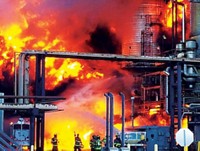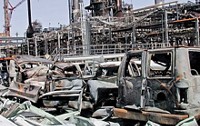Advertisement
Grab your lab coat. Let's get started
Welcome!
Welcome!
Create an account below to get 6 C&EN articles per month, receive newsletters and more - all free.
It seems this is your first time logging in online. Please enter the following information to continue.
As an ACS member you automatically get access to this site. All we need is few more details to create your reading experience.
Not you? Sign in with a different account.
Not you? Sign in with a different account.
ERROR 1
ERROR 1
ERROR 2
ERROR 2
ERROR 2
ERROR 2
ERROR 2
Password and Confirm password must match.
If you have an ACS member number, please enter it here so we can link this account to your membership. (optional)
ERROR 2
ACS values your privacy. By submitting your information, you are gaining access to C&EN and subscribing to our weekly newsletter. We use the information you provide to make your reading experience better, and we will never sell your data to third party members.
Safety
Five Die In Refinery Fire
Plant Safety: Tesoro refinery blast is the latest in string of accidents under investigation
by Jeff Johnson
April 12, 2010
| A version of this story appeared in
Volume 88, Issue 15

A deadly accident in the early hours of April 2 at the Tesoro refinery 70 miles north of Seattle has focused attention on the petroleum industry’s plant practices and commitment to worker safety.
Five workers died and two were badly injured at the Anacortes, Wash., refinery during routine maintenance of a naphtha hydrotreater unit, according to Tesoro and the Chemical Safety & Hazard Investigation Board (CSB). The board is investigating this accident as well as another at a Tesoro refinery in Salt Lake City that occurred last October.
“CSB has 18 ongoing investigations,” board Chairman John Bresland says. Of those, seven occurred at refineries, he notes. “This is a significant and disturbing trend that the refining industry needs to address immediately.”
Last year, the Anacortes refinery was cited for 17 “serious” violations by the Washington Department of Labor & Industries (L&I). These citations are the highest category of state violations, and all were for the same unit in which the fire occurred, notes L&I spokesman Hector Castro. At this time, it is unclear whether the problems cited led to the fatal accident, Castro says. Along with CSB, L&I is investigating the accident.
Tesoro’s fines reached $85,700, Castro says. The company paid $12,000 for three of the violations and challenged the others, but the state and the company agreed to abide by the results of an auditor’s review, which is under way.
Castro explains that last year’s Anacortes inspection was part of a national Occupational Safety & Health Administration program to increase refinery inspections. The program began in 2007, driven by the 2005 BP Texas City, Texas, refinery accident that killed 15 workers as well as by reports from CSB finding lax OSHA enforcement of refinery process safety regulations. In the program’s first year, OSHA issued 212 citations for refinery violations and leveled $700,000 in fines (C&EN, March 17, 2008, page 9).
The inspection program continues and is applauded by CSB and the United Steelworkers Union (USW), which represents refinery workers. Last month, OSHA leveled $3 million in fines for safety violations at a BP-Husky refinery near Toledo, Ohio.
Michael Wright, USW director of health, safety, and environment, now wants OSHA to follow up on the earlier inspections to determine whether the refineries corrected problems identified in the citations. He says a worker survey conducted by USW found continuing problems at refineries.
The insurance giant Swiss Re also warns of refinery problems. In a review of the industry done on the heels of the BP Texas City accident, it found “significantly higher” accident-related losses for U.S. refineries compared with the rest of the world. It blamed a combination of operational hazards, including a push to increase production and the greater complexity of U.S. plants.
To help avoid and reduce the impact of accidents, Tesoro and other facilities that produce and handle large amounts of hazardous chemicals are required to develop Risk Management Plans (RMPs) that include a hazard assessment, an accident history, and an emergency response plan in the event of an accident.
The Environmental Protection Agency enforces the program but has never inspected the adequacy of Tesoro’s RMP, says Wally Moon, RMP team leader of EPA’s Region 10, which oversees Washington state. He acknowledges the plan’s importance but said EPA had not gotten to Tesoro.
This lack of RMP enforcement is typical, according to a 2009 report by the EPA Office of Inspector General. The IG found that more than half of U.S. manufacturers had never faced an EPA RMP compliance inspection. The most recent data for refineries are in a 2007 report to Congress showing that only 56 of 150 U.S. refineries have had their RMPs audited by EPA.
Industry groups maintain that safety—with or without inspections—is paramount. According to a statement by the National Petrochemical & Refiners Association, the industry “places the highest emphasis on the safety of refining operations and goes to great lengths to make refineries as safe as possible.”
Tesoro did not respond to C&EN’s interview requests. In a statement, it offered condolences to the families who lost loved ones in the accident and said the company will fully cooperate with investigations.




Join the conversation
Contact the reporter
Submit a Letter to the Editor for publication
Engage with us on Twitter